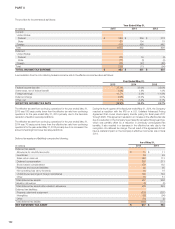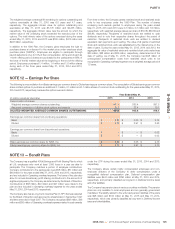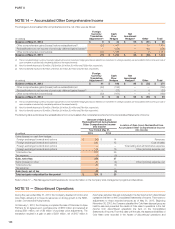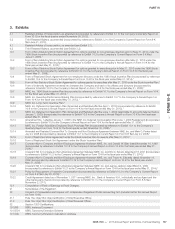Nike 2015 Annual Report Download - page 69
Download and view the complete annual report
Please find page 69 of the 2015 Nike annual report below. You can navigate through the pages in the report by either clicking on the pages listed below, or by using the keyword search tool below to find specific information within the annual report.
PART II
payments while the swaps are outstanding, which are reflected within the
Cash provided by operations component of the Consolidated Statements of
Cash Flows. The Company recorded no ineffectiveness from its interest rate
swaps designated as fair value hedges for the years ended May 31, 2015,
2014 or 2013. As of May 31, 2015, interest rate swaps designated as fair
value hedges had a total notional amount of $100 million.
Net Investment Hedges
The Company has, in the past, hedged and may, in the future, hedge the risk
of variability in foreign-currency-denominated net investments in wholly-
owned international operations. All changes in fair value of the derivatives
designated as net investment hedges, except ineffective portions, are
reported as a component of Other comprehensive income along with the
foreign currency translation adjustments on those investments. The Company
classifies the cash flows at settlement of its net investment hedges within the
Cash used by investing activities component of the Consolidated Statement
of Cash Flows. The Company assesses hedge effectiveness based on
changes in forward rates. The Company recorded no ineffectiveness from its
net investment hedges for the years ended May 31, 2015, 2014 or 2013. The
Company had no outstanding net investment hedges as of May 31, 2015.
Undesignated Derivative Instruments
The Company may elect to enter into foreign exchange forwards to mitigate
the change in fair value of specific assets and liabilities on the balance sheet
and/or the embedded derivative contracts explained below. These forwards
are not designated as hedging instruments under the accounting standards
for derivatives and hedging. Accordingly, these undesignated instruments are
recorded at fair value as a derivative asset or liability on the Consolidated
Balance Sheets with their corresponding change in fair value recognized
in Other (income) expense, net, together with the re-measurement gain or loss
from the hedged balance sheet position or embedded derivative contract.
The Company classifies the cash flows at settlement from undesignated
instruments within the Cash provided by operations component of the
Consolidated Statements of Cash Flows. The total notional amount of
outstanding undesignated derivative instruments was $4.4 billion as
of May 31, 2015.
Embedded Derivatives
As part of the foreign currency adjustment program described above, an
embedded derivative contract is created upon the factory’s acceptance of
NIKE’s purchase order for currencies within the factory currency exposure
indices that are neither the U.S. Dollar nor the local or functional currency of
the factory. Embedded derivative contracts are treated as foreign currency
forward contracts that are bifurcated from the related purchase order and
recorded at fair value as a derivative asset or liability on the Consolidated
Balance Sheets with their corresponding change in fair value recognized
in Other (income) expense, net, from the date a purchase order is accepted
by a factory through the date the purchase price is no longer subject to foreign
currency fluctuations.
In addition, the Company has entered into certain other contractual
agreements which have payments that are indexed to currencies that are not
the functional currency of either substantial party to the contracts. These
payment terms expose NIKE to variability in foreign exchange rates and
create embedded derivative contracts that must be bifurcated from the
related contract and recorded at fair value as derivative assets or liabilities on
the Consolidated Balance Sheets with their corresponding changes in fair
value recognized in Other (income) expense, net until each payment is settled.
At May 31, 2015, the notional amount of all embedded derivatives
outstanding was approximately $205 million.
Credit Risk
The Company is exposed to credit-related losses in the event of
nonperformance by counterparties to hedging instruments. The
counterparties to all derivative transactions are major financial institutions with
investment grade credit ratings. However, this does not eliminate the
Company’s exposure to credit risk with these institutions. This credit risk is
limited to the unrealized gains in such contracts should any of these
counterparties fail to perform as contracted. To manage this risk, the
Company has established strict counterparty credit guidelines that are
continually monitored.
The Company’s derivative contracts contain credit risk related contingent
features designed to protect against significant deterioration in counterparties’
creditworthiness and their ultimate ability to settle outstanding derivative
contracts in the normal course of business. The Company’s bilateral credit
related contingent features generally require the owing entity, either the
Company or the derivative counterparty, to post collateral for the portion of
the fair value in excess of $50 million should the fair value of outstanding
derivatives per counterparty be greater than $50 million. Additionally, a certain
level of decline in credit rating of either the Company or the counterparty could
also trigger collateral requirements. As of May 31, 2015, the Company was in
compliance with all credit risk related contingent features and had derivative
instruments with credit risk related contingent features in a net liability position
of $4 million. Accordingly, the Company was not required to post any
collateral as a result of these contingent features. Further, as of May 31, 2015,
the Company had received $968 million of cash collateral and $74 million of
securities from various counterparties to its derivative contracts (refer
to Note 6 — Fair Value Measurements). Given the considerations described
above, the Company considers the impact of the risk of counterparty default
to be immaterial.
NOTE 18 — Operating Segments and Related Information
The Company’s operating segments are evidence of the structure of the
Company’s internal organization. The NIKE Brand segments are defined by
geographic regions for operations participating in NIKE Brand sales activity.
Each NIKE Brand geographic segment operates predominantly in one
industry: the design, development, marketing and selling of athletic footwear,
apparel and equipment. The Company’s reportable operating segments for
the NIKE Brand are: North America, Western Europe, Central & Eastern
Europe, Greater China, Japan and Emerging Markets, and include results for
the NIKE, Jordan and Hurley brands. The Company’s NIKE Brand Direct to
Consumer operations are managed within each geographic operating
segment. Converse is also a reportable segment for NIKE, Inc., and operates
in one industry: the design, marketing, licensing and selling of casual
sneakers, apparel and accessories.
Global Brand Divisions is included within the NIKE Brand for presentation
purposes to align with the way management views the Company. Global
Brand Divisions primarily represent NIKE Brand licensing businesses that are
not part of a geographic operating segment, and demand creation, operating
overhead and product creation and design expenses that are centrally
managed for the NIKE Brand.
Corporate consists largely of unallocated general and administrative
expenses, including expenses associated with centrally managed
departments; depreciation and amortization related to the Company’s
headquarters; unallocated insurance, benefit and compensation programs,
including stock-based compensation; and certain foreign currency gains and
losses, including certain hedge gains and losses.
The primary financial measure used by the Company to evaluate performance
of individual operating segments is earnings before interest and taxes
(commonly referred to as “EBIT”), which represents Net income before
Interest expense (income), net and Income tax expense in the Consolidated
Statements of Income. Reconciling items for EBIT represent corporate
130
























